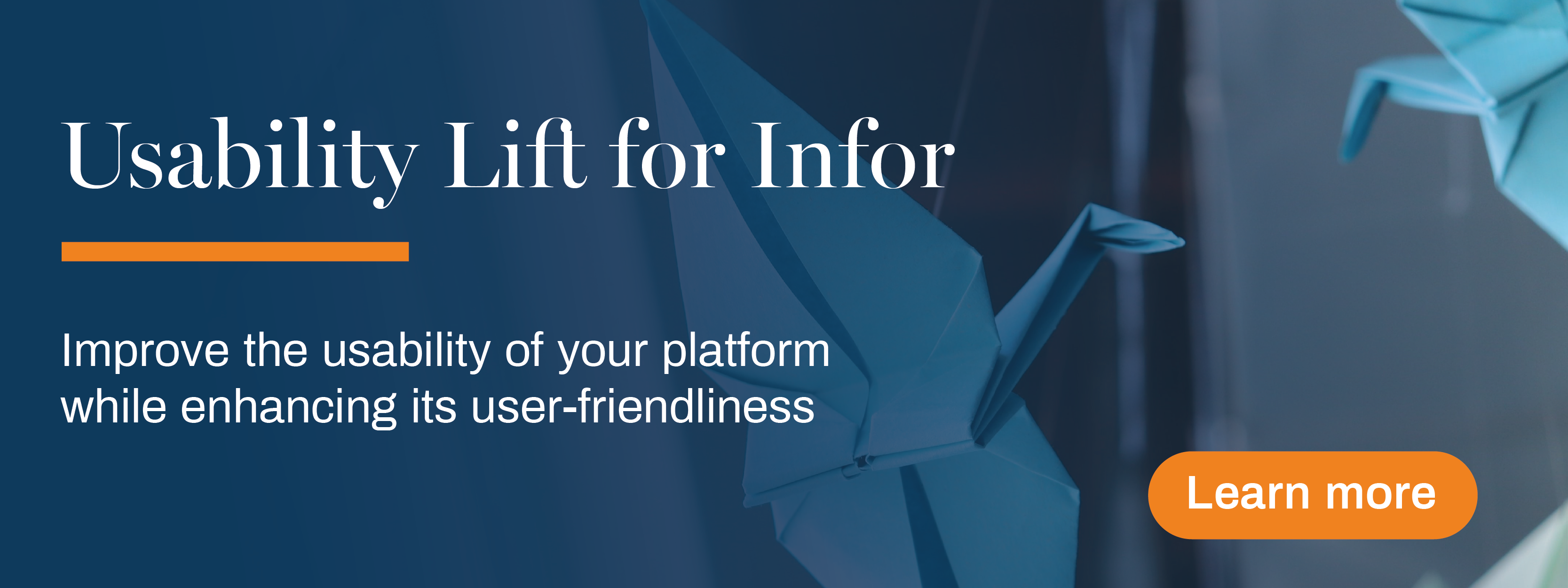No doubt that the cloud offers a wealth of opportunities for modern businesses. Yet, surprisingly, many companies that have already invested in it (or are planning to) aren't fully taking advantage of its potential. This oversight can impact efficiency and productivity.
In this Q&A blog, we sit down with Ole-Petter Hammersland and Robert Langerud, Business Consultants at Columbus, to discuss how businesses can make the most of their platform using Infor M3 as an example. They explore common reasons for the underutilization of practical features, differentiate between usability and UX, and suggest what should be done to "lift" your platform to a new level.
Q: According to statistics from various consulting companies, many businesses fail to fully leverage the potential of their ERP systems. Why do you think this happens?
Ole-Petter:
In my opinion, this issue can be linked to the demanding nature of ERP implementation and upgrades. These projects often come with strict timelines and budgets, which may prioritize the overall improvement of business processes over the end-user perspective. In many cases, the primary focus remains on successful implementation rather than what happens afterward.
Sometimes, businesses may also choose to postpone implementing functionalities that are not deemed 100% necessary until the go-live phase, and then they simply don't have the time to revisit them.
To succeed, businesses need to allocate time to ensure a smooth transition for end-users. This is particularly important considering the significant impact of implementing a new ERP system on any organization.
Robert:
I completely agree. In upgrade or implementation projects, the primary focus often remains on addressing daily processes as they are. This occurs because people may not fully grasp the capabilities and potential value of Infor CloudSuite for their business. Usability is frequently overlooked in project delivery.
In larger projects, customers must allocate time to manage the project and handle their daily business operations. Once the system goes live, the priority shifts to returning to normal operations and addressing daily issues, leaving limited time to focus on usability enhancements. This underscores the need to consider how the system can streamline processes, rather than just implementing the system itself. Implementation partners also have a responsibility to provide the right expertise and assist customers in defining a project scope that maximizes technology utilization. It's not about enforcing strict processes but rather adopting an approach that aligns with each organization's unique needs.
Q: You mentioned the importance of usability several times. What’s the difference between usability and user experience (UX)?
Ole-Petter:
Usability primarily focuses on enhancing efficiency and learnability to simplify the system for new users. Given that the Gen Z generation are only holding jobs for 2 years 3 months on average, it's essential that the learning curve of working with an ERP system is short. Ideally, users should be proficient in most business processes in the ERP system by day five.
Error prevention is also a specific aspect of usability, while UX is more about the sensory and emotional aspects — how it feels, its aesthetics, placement, visual appeal, etc. Achieving a greater UX often requires more resources due to the involvement of UX designers and developers.
Robert:
UX deals with the touch and feel of the interface, the overall user experience. Usability, on the other hand, is about working smarter, not harder—optimizing internal processes to enhance efficiency.
Q: What are the most commonly missed opportunities, particularly for Infor users when they go live?
Ole-Petter:
I'd say the underutilization of home pages and workflows. These serve as entry points to the ERP system, enhancing user-friendliness and streamlining processes. It surprises me when I talk to long-term Infor users who haven't implemented workflows or designed a home page.
With a capable partner or an internal super user interested in these features, organizations don't need an expert to implement these technologies.
Workflows, in particular, can be a foundation for future advancements like machine learning. Constructing efficient workflows to streamline processes enables businesses to achieve quick wins at a reasonable cost with a swift implementation – the tools are already available.
Robert:
I'd like to add to what Ole-Petter mentioned about home pages. In the past, businesses often had to review transaction data, sometimes comprising hundreds of lines in spreadsheets, searching for discrepancies or issues. Employees also had to export ERP data to Excel and manually search for delayed orders or missing information.
With technological advancements and the use of home pages, companies can get immediate answers, saving time and simplifying problem-solving tasks.
Personalization allows users to customize their system experience to match their specific needs and preferences. This contributes to a more efficient and user-friendly ERP environment.
Shortcuts are another valuable asset. In standard systems, users may need to perform activities by clicking multiple times with the mouse. Shortcuts, hyperlinks, and automations can significantly reduce these steps, allowing businesses to work smarter.
Scripting is essential for automating repetitive tasks. For example, if a particular order type consistently requires the same input value, like "AAA," in a special field, scripting can automate this process. This not only saves time but also reduces the chances of manual errors.
Q: Which usability enhancements in Infor M3 have our customers found particularly beneficial in their operations?
Robert:
One of the most valuable benefits has been the direct access to relevant information. This capability allows them to stay focused on their core business processes. Easy access to essential data not only improves efficiency but also boosts overall job satisfaction. When users can efficiently perform their tasks without spending time sifting through extensive lists or data, it enhances their sense of accomplishment and well-being.
Q: If I'm a company that wants to improve usability of my M3 platform, what steps do I need to take?
Ole-Petter:
I recommend investing in your internal resources and creating super users in your organization. You can also approach your partner and request a “crash course” on these technologies. It's crucial that when your partner starts a project, your team members are well-versed in these possibilities and can ask informed and critical questions.
Consider this “crash course” as an opportunity to become familiar with these technologies, to understand their practical implications. This way, during the project and testing phases, you can confidently question your partner, suggesting alternative approaches to problem-solving. This proactive approach is a great way to move forward.
Robert:
I agree with Ole-Petter. Customers shouldn't hesitate to ask questions like, "Is it possible to automate this process?" as it can lead to more efficient solutions. Initially, understanding the system's inner workings is essential to grasp why you're getting specific outputs. However, once you've gained that understanding, you can streamline processes through automation, achieving more with less effort. Laziness, in this context, can be a driver of progress — achieving more with less effort.
Q: Columbus has a “Usability lift” offer that helps businesses make the most of their Infor M3 platform. How does it work?
Ole-Petter:
We designed “Usability lift” offer to provide structured assistance to our customer, ensuring you get the most value of your investments. The offer includes a series of workshops where we encourage open and collaborative discussions.
During these workshops, we sit down with your team to explore your current work processes and gather feedback on the challenges you face. We then organize this feedback, pinpoint areas where valuable improvements can be made, and prioritize them accordingly. After that, we align these areas with the capabilities of the system and present all this information in an easy-to-use report.
The report serves as a solid foundation for your improvement plan. It includes high-level estimates of the effort required for each improvement, helping you decide which ones to focus on first.
Sometimes, we can even make small changes during the workshops that show immediate results.
Robert:
To summarize, the 'Usability Lift' offer is a 'fast-track' for your business to make the most of your cloud or on-premises Infor M3 platform.
Let me share a real customer case. TOPRO Industri AS engaged in the 'Usability Lift' offer, which included six workshops. The primary goal was to identify new ways to simplify processes using technology and leverage new M3 features.
These workshops covered a range of areas, including a general system review and specific processes such as sales/orders, finance, purchasing, manufacturing, and warehousing/logistics. The outcome was an analysis report documenting improvement opportunities for TOPRO Industri to assess and prioritize.
What's interesting is that TOPRO Industri addressed some of these points internally, utilizing their own expertise, while seeking assistance for others. The experience was positive for both Columbus and the customer, leading to a better understanding of the system and improved process efficiency.
We strongly encourage you to focus on usability, and if you're interested in the details of our approach, please don't hesitate to reach out. We'll be happy to assist.


